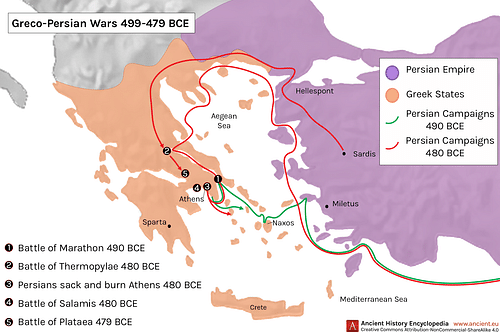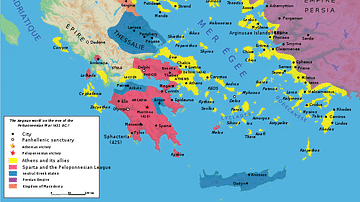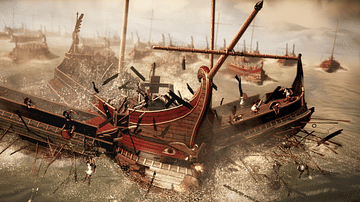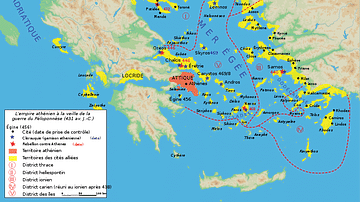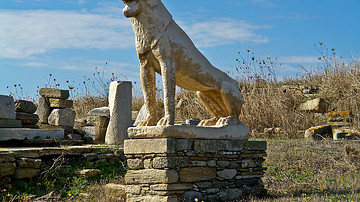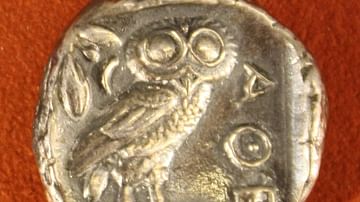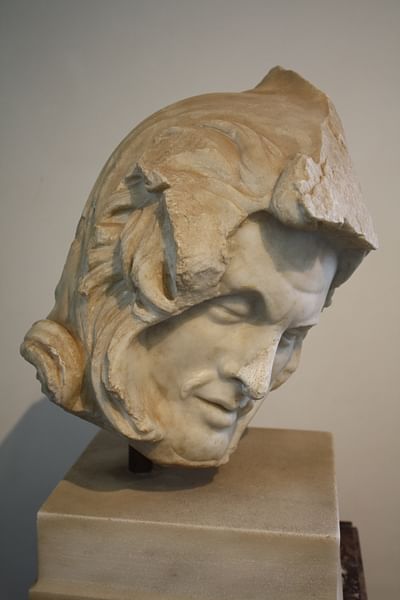
The Peace of Callias (aka Kallias) refers to a possible peace treaty made in the mid-5th century BCE between Athens and Persia following the Persian Wars. The existence of such a treaty is not agreed upon by all historians, and if it did exist, its precise terms are also disputed. Even the possible date of such a treaty continues to be debated amongst scholars, with either the 460s BCE or c. 449 BCE being the most popular suggestions. The treaty is named after the wealthy Athenian statesman Callias who may have led the Athenian ambassadors during the peace discussions. Even if a treaty by this name was never drawn up, it is true that there was an end to the hostilities between Athens and Persia in the mid-5th century BCE.
Existence & Dating
The existence of a peace treaty between The Achaemenid Empire of Persia and the Greek city-state of Athens called the 'Peace of Callias' is not known for certain, primarily because the Greek historian Herodotus (c. 484 - c. 413 BCE) does not mention it and, more significantly, Thucydides (c. 460 - c. 398 BCE), who is our principal contemporary source on the end of the Persian Wars, does not mention it explicitly either. However, scholars point out that neither author gave very much attention to the precise period in question and suggest that certain passages in Thucydides' work do constitute indirect evidence that there was such a treaty between the two powers. Even so, doubts have existed going all the way back to Theopompos in the 4th century BCE. That Greek historian had perhaps seen a copy of the treaty but, because he thought it an original and it was written in the more recently used Ionic alphabet, did not think it genuine (although Ionic Greek was used on occasion in 5th-century BCE documents). On the other hand, the existence of some sort of agreement between Athens and Persia is noted by such ancient figures as the Athenian orators Demosthenes and Lycurgus in the 4th century BCE, as well as later authors like Plutarch and Aelius Aristides writing in the 2nd century CE.
Assuming there was a treaty, the next problem is when was it agreed upon? Some scholars prefer a date in the decade of the 460s BCE while others suggest 449 BCE. Still others believe that both dates are relevant and that the treaty was signed in the 460s BCE and then renewed in 449 BCE. What is certain is that any major hostilities between Persia and Athens had come to an end by the middle of the 5th century BCE.
Callias
The Treaty is named after Callias who was an Athenian statesman belonging to one of the richest families in the city-state. He was known to have held the prestigious position of torchbearer (dadouchos) in the rites of the Eleusinian Mysteries cult. His wife was Elpinice, the sister of Cimon (c. 510 – 450 BCE), the Athenian statesman and successful military commander. Callias fought with distinction at the Battle of Marathon against a Persian army in 490 BCE. His reputation as a peacemaker was consolidated by his role as a negotiator in the Thirty Years Peace between Athens and Sparta in 446 BCE.
Causes of the Treaty: Persian Wars
The Persian Achaemenid Empire had been fighting the Greeks throughout the 5th century BCE with Darius I (r. 522-486 BCE) invading Greece in 491 BCE and his successor Xerxes (r. 486-465 BCE) in 480 BCE. These invasions resulted in some of the most famous battles in history, all won by the Greek city-states, led by Athens and Sparta: Marathon (490 BCE), Thermopylae (August 480 BCE), Salamis (September 480 BCE) and Plataea (479 BCE). After the Battle of Plataea, there followed 30 years of on-off warfare, but on a smaller scale than previously, between Greece and Persia.
Athens formed the Delian League (aka Athenian League) in 478 BCE, an association of some 300 Greek city-states, in order to defend against any further Persian aggression. Taking over the League's treasury and imposing contributions on members - even those who wanted to leave - meant that the League, in effect, became the Athenian Empire. The Delian League was certainly useful in this period of continued intermittent warfare and famously defeated a Persian army at the Battle of Eurymedon in 466 BCE. It is, therefore, this date that some scholars suggest as the time when the Peace of Callias was drawn up.
In 460 BCE the First Peloponnesian War broke out between Athens and Corinth, with Sparta occasionally intervening. The war would last until 446 BCE. Athens was now using the Delian League as a tool to subdue fellow Greek city-states. The need to ensure Persia did not create any trouble while Athens was preoccupied with the First Peloponnesian War may have been the motivation for ensuring a lasting peace with the then Persian ruler, Artaxerxes I (r. 464-425 BCE). However, the Athenians themselves stirred up hostilities by supporting a revolt in Egypt against Persian rule there. The Athenians sent an expedition in c. 459 BCE in support but it was a disaster for the Greeks and ended in 454 BCE. A joint Athens-Sparta expedition on Cyprus, again against Persia, was more successful, although Cimon was killed in the action in 451 BCE. Consequently, now that Persia had been defeated again, some historians prefer the 449 BCE date for the Peace of Callias.
Purpose of the Treaty
The treaty, if we suppose it existed, was designed to end the hostilities between Persia and Athens and define the new political map of the Aegean following the Persian Wars. Probably not a detailed treaty, the 'Peace' was more likely an agreement on where the two powers had a sphere of influence and so ensured one power did not interfere in the imperialistic plans of the other. The general terms of the treaty reportedly prohibited Persia from entering western Asia Minor and the Aegean. No Persian satrap was allowed within three days' journey of the Aegean coast and no Persian ship could pass Phaselis on the southern coast of Lycia in Ionia (now Tekirova in Turkey). At the same time, Athens promised to leave the Black Sea to Persia and not attack Persian territory.
The most explicit ancient source on the Peace of Callias comes from the Library of Diodorus Siculus, the 1st-century CE Greek historian (even if most modern historians consider the terms a fiction):
Artaxerxes the king, however, when he learned of the reverses his forces had suffered at Cyprus, took counsel on the war with his friends and decided that it was to his advantage to conclude a peace with the Greeks. Accordingly he dispatched to the generals in Cyprus and to the satraps the written terms on which they were permitted to come to a settlement with the Greeks. Consequently Artabazus and Megabyzus sent ambassadors to Athens to discuss a settlement. The Athenians were favourable and dispatched ambassadors plenipotentiary, the leader of whom was Callias the son of Hipponicus; and so the Athenians and their allies concluded with the Persians a treaty of peace, the principal terms of which run as follows: All the Greeks cities of Asiaare to live under laws of their own making; the satraps of the Persians are not to come nearer to the sea than a three days' journey and no Persian warship is to sail inside of Phaselis or the Cyanean Rocks [near modern Constantinople]; and if these terms are observed by the king and his generals, the Athenians are not to send troops into the territory over which the king is ruler. After the treaty had been solemnly concluded, the Athenians withdrew their armaments from Cyprus, having won a brilliant victory and concluded most noteworthy terms of peace.
(Bk. 12 ch. 4)
The End of the Peace
The treaty/agreement did bring peace but not the end of the Delian League, by now too useful a tool for Athenian ambitions across Greece. Persia did not involve itself militarily in Greek affairs until 412 BCE when the Persian satraps Pharnabazos and Tissaphernes gave aid to a Spartan army in Ionia during the Second Peloponnesian War (431-404 BCE) between Athens and Sparta and their respective allies. The period of relative peace in Greece (at least between Greeks and non-Greeks) between 479 BCE and 431 BCE is known as the Pentekontaetia (meaning 50 year period). Persia would provide money and timber for the Spartans to build a navy formidable enough to take on the naval power of Athens. Thus, Lysander, the Spartan commander, was able to inflict a final and total defeat on the Athenians at Aegospotami near the Hellespont in 405 BCE.
